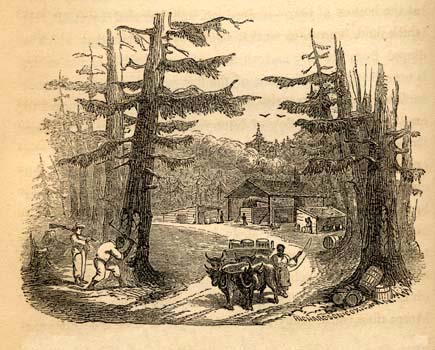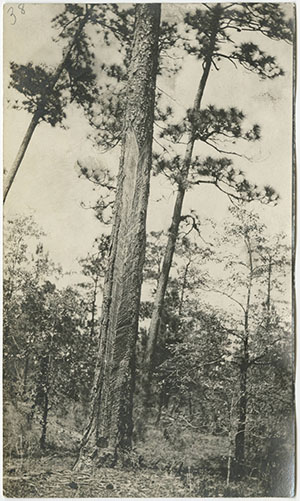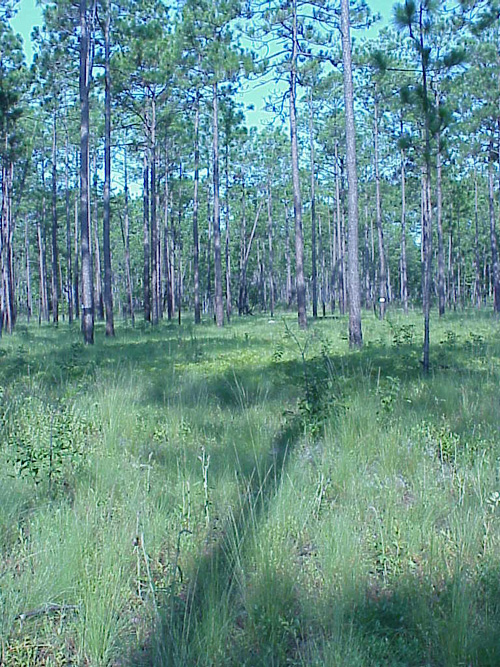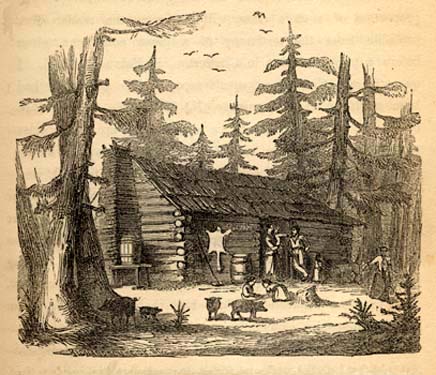Frederick Law Olmsted was a renouned landscape architect who recorded and published writings from his travels during the antebellum period. One of Olmsted's published writings, A Journey in the Seaboard Slave States, included his tour through the "Turpentine Orchards" of Eastern North Carolina. Eastern North Carolina had an abundance of longleaf pines and soil that made it challenging to cultivate anything else in large quantities, thus it was a land of tar, turpentine, and other naval stores. Below are excerpts of this book, A Journey in the Seaboard Slave States, which detail the products, processes, and people Olmsted encountered among the longleaf pines.
Turpentine and naval stores
Turpentine is the crude sap of pine-trees. It varies somewhat, in character and in freedom of flow, with the different varieties; the long-leafed pine (Pinus Palustris) yielding it more freely than any other.
There are very large forests of this tree in North and South Carolina, Georgia, and Alabama; and the turpentine business is carried on, to some extent, in all these States. In North Carolina, however, much more largely than in the others; because, in it, cotton is rather less productive than in the others, in an average of years. Negroes are, therefore, in rather less demand; and their owners oftener see their profit in employing them in turpentine orchards than in the cotton-fields.
In the region in which the true turpentine-trees grow, indeed, there is no soil suitable for growing cotton; and it is only in the swampy parts, or on the borders of streams flowing through it, that there is any attempt at agriculture. The farmer, in the forest, makes nothing for sale but turpentine, and, when he cultivates the land, his only crop is maize; and of this, I was often told, not more than five bushels from an acre is usually obtained. Of course, no one would continue long to raise such crops, if he had wages to pay for the labor; but, having inherited or reared the laborers, the farmer does not often regard them as costing him anything more than what he has to pay for their clothes and food -- which is very little.
Few turpentine-farmers raise as much maize as they need for their own family; and those who carry on the business most largely and systematically, frequently purchase all the food of their hands. Maize and bacon are, therefore, very largely imported into North Carolina, chiefly from Ohio, by the Baltimore and Wheeling rail-road, and from Baltimore to Wilmington or Newbern, by sea.
The turpentine forest is from thirty to eighty miles wide, and extends from near the north-line of North Carolina to the Gulf of Mexico. Until lately, even in North Carolina, the business of collecting turpentine has been confined to such parts of the forest as were situated most conveniently to market -- the value of the commodity not warranting long inland transportation. Recently, the demand has increased, owing, probably, to the enlarged consumption of spirits of turpentine in "burning fluids;" In the mid 1800s, a mixture of alchohol and turpentine referred to as "burning fluid" became popular as a fuel for lamps. The mixture, also called camphene, was inexpensive compared to other lamp fuels,such as whale oil, but was incredibly dangerous. Many people were injured and homes burned when camphene lamps exploded. was manufactured for use in lamps. and the business has been extended into the depths of the forest. It is yet thought a hazardous venture to start the business where more than thirty miles of wagoning is required to bring the spirits of turpentine to a rail-road, or navigable water.
If we enter, in the winter, a part of a forest that is about to be converted into a "turpentine orchard," we come upon negroes engaged in making boxes, in which the sap is to be collected the following spring. They continue at this work from November to March, or until, as the warm weather approaches, the sap flows freely, and they are needed to remove it from the boxes into barrels. These "boxes" are not made of boards, nailed together in a cubical form, as might be supposed; nor are they log-troughs, such as, at the North, maple-sap is collected in. They are cavities dug in the trunk of the tree itself. A long, narrow ax, made in Connecticut, especially for this purpose, is used for this wood-pecking operation; and some skill is required to use it properly. We may see the green hands doing 'prentice work upon any stray oaks, or other non-turpentine trees they can find in the low grounds.
The boxes are made at from six inches to a foot above the roots, and are shaped like a distended waistcoat-pocket. The lower lip is horizontal -- the upper, arched; the bottom of the box is about four inches below the lower lip, and eight or ten below the upper. On a tree of medium size, a box should be made to hold a quart. The less the ax approaches towards the centre of the tree, to obtain the proper capacity in the box, the better, as the vitality of the tree is less endangered; but this is little thought about.
An expert hand will make a box in less than ten minutes; and seventy-five to a hundred -- according to the size and proximity of the trees -- is considered a day's work.
The boxes being made, the bark, and a few of the outer rings of the wood of the tree, are cut off ("hacked") along the edge of the upper lip. From this excoriation, the sap begins to flow about the fifteenth of March, and gradually fills the boxes, from which it is taken by a spoon or ladle, of a peculiar form, and collected into barrels.
The turpentine barrels are made by negro coopers; the staves split from pine-logs, shaved and trimmed. They are hooped with split oak-saplings. Coopers' wages, when hired out, are from $1.50 to $2 a day. A good cooper is expected to make six or seven barrels a day. They are of the rudest construction possible -- the staves being straight, and forming a simple cylinder -- thirty inches long and eighteen inches diameter, headed up at both ends, with a square hole in one end, where the turpentine is poured in. In from seven to ten days after the first hacking, the trees are again scarified. This is done with a hatchet, or with an instrument made for the purpose. A very slight chip, or shave, above the former, is all that is needed to be removed; the object being merely to expose a new surface of the cellular tissue -- the flow from the former being clogged by congelations of the sap.
These hackings being made three or four times a month, the excoriation is constantly advancing higher up the trunk. The slighter the cut, the less the tree is injured, and the slower the advance, and the longer and the more conveniently may the process be carried on: nevertheless, in ninety-nine "orchards" out of a hundred, you will see that the chip has always been much broader and deeper than, with the slightest care to restrict it, it needed to have been. If the "dipping" has commenced when you visit the orchard, you will notice that the turpentine collected has much rubbish -- chips and leaves -- in it, considerably injuring its value. The greater part of this might have been avoided, by having the negroes clean out the boxes in which it had fallen, in the winter; but they seldom take this trouble.
In some orchards, you will see that many trees have been killed by fire. The wire-grass, which grew among the trees the previous year, is frequently set on fire, either accidentally or purposely, when dead and dry, in the spring. It burns slowly, and with little flame, and the living trees, the bark of which is not very inflammable, are seldom injured. But where a tree has been boxed, and the chips lie about it, these take fire, and burn with more flame; so that frequently the turpentine in the box, and on the scarified wood above it, also takes fire, and burns with such intensity as to kill the tree. The danger might be avoided by raking away the chips and leaves, for a foot or two about the roots; but I nowhere saw this precaution taken. I mention these things, by the way, as further illustration of the general inefficient direction of slave-labor; or as indicating, as might be rather claimed by the owners, that the high cost of the labor prevents its direction to these minor points of economy.
By the middle of March, the turpentine is flowing abundantly, and the negroes must be employed in hacking, as each tree requires to be freshly scarified once in a week, or ten days. Soon afterwards, it is necessary to commence dipping, or the removal of the turpentine from the boxes to barrels. There are two ways of arranging the labor for this purpose used by the larger proprietors. In one, all the negroes employed are divided into two classes -- "hackers" and "dippers." The hackers are wholly employed in scarifying the trees. A task, of a certain number of trees, is given to each, which he is required to go over, hacking each tree, once in seven or eight days. The dippers are constantly employed in emptying the boxes, as they fill with turpentine. The other way -- and this is more common -- is to give each hand a task of trees, each of which he is required to both hack and dip statedly. Twenty-five hundred trees give a man five days' employment hacking, and one day dipping, in a week.
From one to four boxes are made in each tree, according to its size; a few inches of bark being left between them. The greater number of trees, from which turpentine is now obtained, are from a foot to eighteen inches in diameter, and have three boxes each. The hacking is carried on year after year, until, in the oldest orchards, it is extended twelve or fifteen feet, and ladders have to be used to carry it further up the trunks of the trees. The turpentine flows from the most recent hack, down over the previously scarified wood of the tree, towards the box, a considerable proportion of it congealing by the way, and remaining attached to the wood. From this adhering portion, a part of the spirits or oil has evaporated in the process of drying; it is, therefore, of less value than that which is taken, in a more liquid condition, from the box. It is occasionally -- perhaps but once a year -- scraped off, and barreled by itself. It is, therefore, known in market as "scrape;" while that which is dipped from the box, and which is of considerably higher value, is termed "dip." The flow of the first year, having but a small surface of wood to traverse, and being, therefore, less exposed to evaporation than the flow of later years, is of higher value than the ordinary dip. It is called "virgin dip." In many of the orchards, at a distance from market, and where, of course, all classes of turpentine are of less value, I observed that the trees had never been scraped -- the proprietor having boxed and hacked more trees than he could apply force enough to both dip and scrape. The dip is lessened, however, by allowing the scrape to accumulate; for much of the flow is thus often made to drop outside of the box. The price of turpentine being now much higher than usual, many of the small proprietors are this year scraping their trees, that have not scraped before. This old "scrape" will be of inferior quality.
Distillation of turpentine
A considerable amount of turpentine is shipped in barrels to Northern ports, where it is distilled; a larger amount is distilled in the State. The proprietors of the large turpentine orchards, themselves, have stills; and those collecting but a small quantity sell to them, or to custom distilleries, owned by those who make distilling alone their business.
The stills used for making spirits or oil of turpentine from the crude gum, are of copper, not materially different in form from common ardent-spirit stills, and have a capacity of from five to twenty barrels; an average size being, perhaps, ten barrels.
The forest distilleries are usually placed in a ravine or valley, where water can be brought to them in troughs, so as to flow, at an elevation of fifteen feet from the ground, into the condensing tank. At a point at which the ground will decline from it in one direction, the still is set in a brick furnace. A floor or scaffold is erected on a level with the bottom of the still-head, and a roof covers all. The still-head is taken off, and barrels of turpentine, full of rubbish as it is collected by the negroes, are emptied in. When the still is full, or nearly so, the still-head is put on, and the joint made tight with clay; fire is made, and soon a small, transparent stream of spirits begins to flow from the mouth of the worm, and is caught directly in the barrel in which it finally comes to market. When all the spirits, which can be profitably extracted, are thus drawn off, the fire is raked out of the furnace, a spigot is drawn from a spout at the bottom of the still, and the residuum flows out -- a dark, thick fluid, appearing, as it runs, like molasses.
Rosin
This residuum is resin, or the rosin of commerce. There is not a sufficient demand for rosin, except of the first qualities, to make it worth transporting from the inland distilleries; it is ordinarily, therefore, conducted off to a little distance, in a wooden trough, and allowed to flow from it to waste upon the ground. At the first distillery I visited, which had been in operation but one year, there lay a congealed pool of rosin, estimated to contain over three thousand barrels. Its appearance was very beautiful; firm and glairThick and viscous, like the white of an egg.; varying in color, and glistening like polished porphyryA purple-red stone.. The rosin from "virgin dip" turpentine, only, was saved here. At the distilleries on the river-banks, a second quality is also saved, while a poorer description is still let run to waste. When it is intended to save the rosin, it is drawn off into a vat of water, which separates the chips and other rubbish, that were contained in the gum, and it is then barreled for market.
To prevent the spirits soaking through the wood and evaporating, the barrels are all washed on the inside with glue. They are made as carefully as possible, and are often brought from the North, and sold at three or four dollars a-piece. Notwithstanding all precaution, the waste from leakage and evaporation is often great, owing to the exceedingly subtile nature of the fluid.
The turpentine lands that I saw were valued at from $5 to $20 an acre. They have sometimes been sold at $2 an acre; and those of Georgia and Alabama can be purchased, to any extent, at that price. From 500 to 1,000 trees (or 2,000 boxes), I judged, stand usually upon an acre. The quantity of turpentine that would flow from these, in a year, I cannot state reliably. According to some statements given me, it would be about fourteen barrels of dip, and two barrels of scrape. Fourteen barrels of dip would give, in distillation, two barrels of spirits, and eight of resin.
At a fifteen barrel still, I found one white man and one negro employed under the oversight of the owner. It kept employed twenty-five men hacking and dipping; running twice, that is, using thirty barrels crude turpentine, a day. Besides these hands, were two coopers, and several wagoners. The wages of ordinary practiced turpentine hands (slaves) are about $120 a year, with board, clothing, etc., as usual.
A North Carolina turpentine orchard, with the ordinary treatment, lasts fifty years. The trees are subject to the attack of an insect which rapidly kills them. Those most severely hacked are chiefly liable to this danger.
The turpentine business is considered to be extremely favorable to health and long life. It is sometimes engaged in by persons afflicted with pulmonary complaints, with the belief that it has a remedial effect.
When the original long-leafed pine has been destroyed, and the ground cultivated a few years, and then "turned out," a bastard variety springs up, which grows with rapidity, but is of no value for turpentine, and of but little for timber. The true variety, rich in turpentine, is of very slow growth. On one trunk, seven inches in diameter, I counted eighty-five ringsCounting the rings of a tree is an accurate way to tell its age; each ring is one year of growth.. Whether there will be a renewed spontaneous growth of the true long-leafed pine, where they are allowed to gradually decay on the ground, I am unable to say.
Tar
Tar is an extract from the pine-wood obtained by charring it. It is made wholly from the heart or "light wood" of the long-leafed pine, which is split into billets of a size convenient for handling and arranging in the tar-kiln. Trees which have been used up in the turpentine business, are the best to use for making tar. The billets are piled in a conical heap, which is covered with turf, much as coal-pits are made at the North. The kiln is usually made upon a hillock, and trenches are made under it, having a mouth a little below it on the hill-side. The proper burning of the kiln to produce the most tar, is an art to be learned by practice. It is made to burn very slowly, to gradually roast out the juices of the pine, so that they will run down, collect in the trench, and flow out at its mouth, where, in the commingled condition known as tar, they are ladled into barrels.
This, is an exceedingly slovenly process, the tar being mixed with sand, and collecting other impurities as it flows through the kiln, and searches a way out on and through the ground. It is for the reason that it is prepared with more care, so as to be free from the admixture of sand, that the tar of Northern Europe always stands at a higher value, and competes with the Carolina tar, even in our own ports.
A new patent process of roasting the pine in iron ovens, the fire not being in contact with it, has lately been introduced, and gives good promise of removing this reproach. The tar is said to be of much superior quality and to be obtained more expeditiously and economically than by the old method.
Pitch
Pitch is a concentration of tar obtained by boiling it. I was unable to obtain any particulars of the process of manufacturing it.
Slaves and other people in the turpentine forests
The negroes employed in this branch of industry, seemed to me to be unusually intelligent and cheerful. Decidedly they are superior in every moral and intellectual respect to the great mass of the white people inhabiting the turpentine forest. Among the latter there is a large number, I should think a majority, of entirely uneducated, poverty-stricken vagabonds. I mean by vagabonds, simply, people without habitual, definite occupation or reliable means of livelihood. They are poor, having almost no property but their own bodies; and the use of these, that is, their labor, they are not accustomed to hire out statedly and regularly, so as to obtain capital by wages, but only occasionally by the day or job, when driven to it by necessity. A family of these people will commonly hire, or "squat" and build, a little log cabin, so made that it is only a shelter from rain, the sides not being chinked, and having no more furniture or pretension to comfort than is commonly provided a criminal in the cell of a prison. They will cultivate a little corn, and possibly a few roods of potatoes, cow-peas and coleworts. They will own a few swine, that find their living in the forest; and pretty certainly, also, a rifle and dogs; and the men, ostensibly, occupy most of their time in hunting.
A gentleman of Fayetteville told me that he had, several times, appraised, under oath, the whole household property of families of this class at less than $20. If they have need of money to purchase clothing, etc., they obtain it by selling their game or meal. If they have none of this to spare, or an insufficiency, they will work for a neighboring farmer for a few days, and they usually get for their labor fifty cents a day, finding themselves. The farmers say, that they do not like to employ them, because they cannot be relied upon to finish what they undertake, or to work according to directions; and because, being white men, they cannot "drive" them. That is to say, their labor is even more inefficient and unmanageable than that of slaves.
That I have not formed an exaggerated estimate of the proportion of such a class, will appear to the reader more probable from the testimony of a pious colporteur, given before a public meeting in Charleston, in February, 1855. I quote from a Charleston paper's report. The colporteur had been stationed at -- county, N. C.: -- "The larger portion of the inhabitants seemed to be totally given up to a species of mental hallucination, which carried them captive at its will. They nearly all believed implicitly in witchcraft, and attributed everything that happened, good or bad, to the agency of persons whom they supposed possessed of evil spirits."
The majority of what I have termed turpentine-farmers -- meaning the small proprietors of the long-leafed pine forest land, are people but a grade superior, in character or condition, to these vagabonds. They have habitations more like houses -- log-cabins, commonly, sometimes chinked, oftener not -- without windows of glass, but with a few pieces of substantial old-fashioned heir-loom furniture; a vegetable garden, in which, however, you will find no vegetable but what they call "collards" (colewort) for "greens"; fewer dogs; more swine, and larger clearings for maize, but no better crops than the poorer class. Their property is, nevertheless, often of considerable money value, consisting mainly of negroes, who, associating intimately with their masters, are of superior intelligence to the slaves of the wealthier classes.
The larger proprietors, who are also often cotton planters, cultivating the richer low lands, are, sometimes, gentlemen of good estate -- intelligent, cultivated, and hospitable. The number of these, however, is extremely small.
Primary Source Citation:
Olmsted, Frederick Law. A Journey in the Seaboard Slave States; With Remarks on Their Economy. New York; London: Dix and Edwards; Sampson Low, Son & co., 1856.
Published online by Documenting the American South. University Library, The University of North Carolina at Chapel Hill. https://docsouth.unc.edu/nc/olmsted/menu.html



